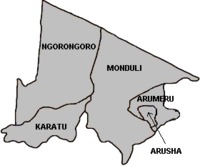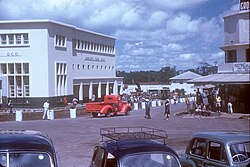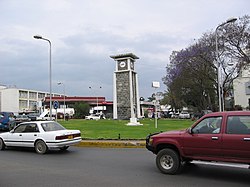Arusha: Difference between revisions
| Line 188: | Line 188: | ||
==See also== |
==See also== |
||
* [[Arusha Accords]] |
* [[Arusha Accords]] |
||
* [[Arusha Cultural Heritage Centre]] |
|||
* [[Arusha Declaration]] |
* [[Arusha Declaration]] |
||
* [[Arusha National Park]] |
* [[Arusha National Park]] |
||
Revision as of 00:00, 22 November 2009
Arusha | |
|---|---|
| Arusha with a view of Mount Meru Arusha with a view of Mount Meru | |
 Location of Arusha City in Arusha Region | |
| Country | |
| Region | Arusha Region |
| Incorporated Town | 1948 |
| Incorporated City | 1 July 2005 |
| Government | |
| • Type | Municipal Council |
| Population (2002) | |
| • Total | 270,485 |
| Time zone | UTC+3 (EAT) |
| • Summer (DST) | UTC+3 (not observed) |
| Area code | 027 |
- This article refers to the city of Arusha. For other uses, see Arusha (disambiguation).
Arusha is a city of northern Tanzania surrounded by some of Africa's most famous landscapes and national parks. Beautifully situated below Mount Meru on the eastern edge of the eastern branch of the Great Rift Valley, it has a pleasant climate and is close to Serengeti, Ngorongoro Crater, Lake Manyara, Olduvai Gorge, Tarangire National Park, and Mount Kilimanjaro, as well as having its own Arusha National Park on Mount Meru. Arusha is the capital of the Arusha Region and has a population of 270,485 (2002 census).
Geography and climate
Despite its proximity to the equator, Arusha's elevation of 1400 m on the southern slopes of Mount Meru keeps temperatures down and alleviates humidity. Cool dry air is prevalent for much of the year. The temperature ranges between 13 and 30 degrees Celsius with an average around 25 degrees. It has distinct wet and dry seasons, and experiences an eastern prevailing wind from the Indian Ocean, a couple of hundred miles east. Almost within the entire city; if you go north you will be going up hill, and going south is always down hill.
Modern history

Official documents ceding independence to Tanzania were signed by the United Kingdom at Arusha in 1961. The Arusha Declarations for Self Reliance in Tanzania were signed in 1967 in Arusha.
The Arusha Accords were signed at Arusha on August 4, 1993, by representatives of competing factions in the Rwandan civil war.
In 1994 the UN security council decided by its Resolution 955 of 8 November 1994 that Arusha should host the International Criminal Tribunal for Rwanda. The establishment of the tribunal with its employees has influenced the local economy of Arusha. The tribunal is expected to finish its operations in 2010, although there are recent doubts that it will be ready by then.
Arusha officially became a city on 1 July 2006[1] .
Industry and economy
The primary industry of the region is agriculture, with large vegetable and flower producers sending high-quality produce to Europe. Small-scale agriculture was badly hit by the coffee crisis of recent years and is now largely subsistence farming. Arusha has several factories including a brewery, tyre and fibreboard plant, and a large pharmaceuticals maker.
The region around Arusha is the sole source of a gem-quality mineral called Tanzanite, currently produced in large quantities by corporate mining concerns.
Tourism is also a major contributor to the economy in Arusha, being the second largest contributor of income in Tanzania. Given the town's location near popular attractions such as Mount Kilimanjaro, Serengeti National Park, and the Ngorongoro Conservation Area, Arusha has become a popular staging point for tourists visiting Tanzania for photo safaris and hiking treks to Mt. Kilimanjaro. Many documentary and feature-length films have been set in and around Arusha, including the 1962 Howard Hawks film Hatari with John Wayne.
Arusha is home to the offices of the East African Community, and plays host to the International Criminal Tribunal for Rwanda and the African Court on Human and Peoples' Rights, all of which contributes to the local economy.
Districts



Among Arusha's notable districts are the Central Business Area, located by the Clocktower, Sekei in the North-West which is largely residential with a vibrant nightlife, Njiro, a rapidly-growing suburb in the South, and Tengeru, a lively market-town in the East.
North of Arusha is a district called Longido. It is about 90 minutes north of Arusha by daladala along the Arusha-Nairobi Road. Robanda Safari Camp is one of the favorite Safari Camp. Robanda Safari Camp is located just outside Serengeti Ikoma Gate. This location was carefully chosen so as to be right in the path of the wildebeest migration. The best time to witness this spectacular migration is from May to August and frm October to December. There is a high animal concentration year round though, with big herds of wildebeest and zebra, elephant and girafe. Other animal species include lion, hyena, gazelle, topi, buffalo,...
Transport
Arusha is mostly served by Kilimanjaro International Airport for international travellers, some 60 kilometres (37 mi) east, approximately halfway to Moshi. The airport provides international and domestic flights. Arusha Airport is a smaller domestic airport in the west of the city, currently undergoing expansion. It serves more than 87,000 passengers yearly, amazingly for its size. It is surrounded by hills to the north and east; the local habitat is a mix of savanna woodlands, agriculture and remnant forest. There are no passenger train services to or from Arusha, but there are regular coaches (buses) to Nairobi, Dodoma and Dar Es Salaam, plus other local towns.
Culture
Arusha is a pleasant city, due to its moderate weather, location, beautiful countryside and lively music scene. Tanzanian hip-hop is currently popular with the youth market. It is mostly performed in Swahili, with various genres influenced by African American music, locally known as Bongo Flava. A good example of this genre is the band, X Plastaz, singers Nakaaya, Watengwa Waturutumbi etc..
Arusha is home to many of Tanzania's festivals, and the yearly festival is hosted by a few Tanzanian corporate sponsors that attract various artists from around the world. Artists like Shaggy and Ja Rule are just a few of the world's most popular artists to perform in the city of Arusha.
Arusha also hosts the annual Arusha Nane Nane Agricultural show. Nane Nane is one of the many vibrant public holidays in Tanzania, held on August 8 (the 8th of the 8th month, nane nane means "eight eight" in Swahili). Nane Nane is marked on August 8 every year where farmers and other stakeholders exchange knowledge and business. It attracts up to a half million people every year.
Arusha is also known for its vibrant night life, with popular local night clubs like, Colobus Club and the Blue Triple 'A'.
Schools
There are three international schools in and around Arusha: International School Moshi (Arusha Campus), Arusha International school, Braeburn School, and St Robert's International School[1] The School of St Jude provides free education to children from the poorest families.
International School Moshi was founded in 1969 and now has 460 students from 46 nationalities on two campuses in Moshi and Arusha. Arusha campus was established in 1986 and now has 200 day students, and offers courses from pre-kindergarten to grade 10. Grades K-10 follow the International Baccalaureate Primary years programme (PYP) and Middle Years programme (MYP) curriculum with an African and international perspective. It has been an IB World school since 2007.[2]
Arcadia University offers Undergraduate semester long and summer programs in Tanzania, as well as Graduate summer programs to study at the Nyerere Centre for Peace Research.
Sports
Arusha is Tanzania's rugby home with the national team playing its international matches there. Southern Pool A of the 2007 Castel Beer Trophy was hosted here too.
Arusha FC, playing in Sheikh Amri Abeid Memorial Stadium, represents the city in Tanzanian league football.
Sister cities
Trivia
- Arusha is also the Hindi name for the rising sun.
- Arusha's clock tower 03°22′20.5″S 036°41′40.1″E / 3.372361°S 36.694472°E is popularly supposed to be situated at the midpoint between Cairo and Cape Town, therefore representing the halfway point between the two termini of the old British Empire in Africa. However, the actual great circle midpoint between these two cities lies in central Congo. The clock tower is currently adorned by the logo of the Coca-Cola Company.
- Arusha was the setting for the 1962 film Hatari! directed by Howard Hawks and starring John Wayne.
- A slang name for the city among locals is "A-Town".
- Princess Margaret visited Arusha in 1956
- In the video game Halo 3, a highway sign is seen that says "Arusha", though it is crossed out, suggesting that the city was destroyed by the Covenant or The Flood
See also
- Arusha Accords
- Arusha Cultural Heritage Centre
- Arusha Declaration
- Arusha National Park
- Arusha Region
- Lake Manyara
- Longido
- Meru
- Mount Meru (Tanzania)
- Selian
- Tanzania
- Tarangire National Park
- Umba Valley
See also
3°22′S 36°41′E / 3.367°S 36.683°E
References
- ^ Arusha Times
- ^ "International School Moshi, Arusha Campus". IB World Schools. IBO. Retrieved 2008-10-23.
External links
- Arusha NGO Network
- Website of the Arusha Times
- International School Moshi (Arusha Campus)
- Kisongo Academic college
- No Limits Foundation
- St. Constantine's international school
- School of St Jude
- Mambo Arusha
3°22′S 36°41′E / 3.367°S 36.683°E{{#coordinates:}}: cannot have more than one primary tag per page
